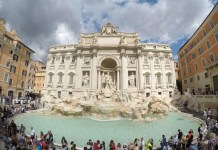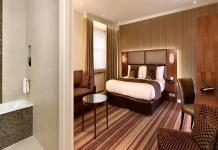Last updated: 06/11/2022
Discover all the details to visit Sintra National Palace, a historic palace built over several centuries, with unique architecture and decoration.
THE NATIONAL PALACE OF SINTRA
Located in the center of the historic village of Sintra, just over 30 km northwest of Lisbon, the National Palace of Sintra, also called Palácio da Vila, is the best preserved medieval royal residence in Portugal. With medieval, Gothic, Manueline, Renaissance and Romantic architectural features, the palace was built in different periods and inhabited continuously by the Portuguese Royal Family from the 15th century until 1910. The palace consists of several rooms, chambers, patios, terraces, offices, stairs, vegetable gardens and gardens. Until the 18th century, the Sintra National Palace served as the center of economic and legal management in the region.

The Palace was a place of extreme importance for the history of Portugal. It was the place where King Afonso V (1438-1477) was born and died; in which D. João II was acclaimed king in 1481; where D. Manuel I received the news of the discovery of Brazil in 1500; and one of its rooms served as a prison for D. Afonso VI (from 1676 until his death in 1683), deposed by his brother D. Pedro II.
A LITTLE OF HISTORY…
The National Palace of Sintra is made up of many royal palaces that have been built, expanded and renovated over the centuries. The palace we see today is totally different from the primitive one that dates back (perhaps) to the 8th century, when the region was dominated by the Moors. It is believed that the palace would have served as a dwelling for the Moorish rulers and, after 1147, for the Christian kings, once the village was conquered by the first portuguese king, D. Afonso Henriques. Then, check out the main moments of the palace.

>> 13TH CENTURIES: FIRST WORKS
After the reconquest of Sintra, it took some time for Portuguese monarchs to take an interest in the palace. They were probably the king D. Dinis (1261-1325) and his wife D. Isabel de Aragão (1271-1226) the first to take an interest in the place, having built a Chapel and some of the oldest spaces in the castle, including what became the D. Afonso VI Prison Room in the 17th century.
>> 15TH CENTURY: JOANINA WING
This core corresponds to Royal Palace built in the reign of D. João I (1357-1433) and of D. Filipa de Lencastre (1360-1415). Much of the palace dates back precisely to the time of the king. D. João I, who ordered a major building project begun in 1415. most buildings around the central courtyard were built at this time, including the main building on the facade with the entrance arches and windows; conical kitchen chimneys; The Swan Room; The Room of the Handles; and patios decorated with tiles.

>> 15th AND 16th CENTURIES: MANUELINA WING
Palace of D. Manuel I (1469-1521), built in the 16th century, it is formed by the hierarchical alignment of chambers: Room, Antechamber, Chamber and Wardrobe, reflecting the medieval manorial regime. during the reign of D. Manuel I, were built at Arab room, with tiles and a Moorish-style fountain in the center; and the richly decorated Coat of Arms Room, built between 1515 and 1518; in addition to redecorating most of the rooms with colorful tiles made in Seville.

>> 17th AND 18th CENTURIES: D. AFONSO VI AND EARTHQUAKE
- D. Afonso VI: In the following centuries the palace continued to be inhabited by kings from time to time, gaining new decoration in the form of paintings, tile panels and furniture. King Afonso VI, who was mentally unstable, was deposed by his brother Pedro II and was imprisoned in one of the palace rooms from 1676 until his death in 1683.
- 1755 EARTHQUAKE: The palace suffered damage after the massive earthquake of 1755, in particular the tower over the Arab Room, which collapsed. At the end of the 18th century, Queen Maria I redecorated and reconfigured the rooms in the Manuelina Wing.
>> 19th, 20th and 21st CENTURIES: END OF THE MONARCHY
- CONSTITUTIONAL MONARCHY: With the end of the Ancien Régime and the implementation of a Constitutional Monarchy in 1822, several rooms were adapted to house new functions of the royal family, which ceased to be the center of political decision. The use became more residential and closer to current models and the queen mother, D. Maria Pia, was the last queen of Portugal to inhabit the palace.
- NEW STATE: With the end of the monarchy and the foundation of the Republic, in 1910, the palace became a National Monument. During the dictatorial regime of the Estado Novo (1933-1974), the Sala Grande of D. Manuel I was recovered as a result of nationalist and imperialist propaganda. In the 1940s, it was restored to try to return to the original decoration with old furniture brought from other palaces and looking to restore the tile panels.
- CURRENT DAYS: In 1995, together with other attractions in the Cultural Landscape of Sintra, the Castle was classified as UNESCO Cultural Heritage of Humanity. In 2000, the Parques de Sintra organization took over the management of the palace. Since then, the site has become a major tourist attraction and is one of the most visited in the country.

HIGHLIGHTS OF THE VISIT TO THE NATIONAL PALACE OF SINTRA
Below is the official map of the National Palace of Sintra. Next, are the main highlights of the visit divided into 20 highlights that tell a little of the history of each room and the main items on display. You can also get a taste of the visit by accessing this 360º virtual tour palace official. We will then go into more detail about each of the selected highlights to make your visit easier.
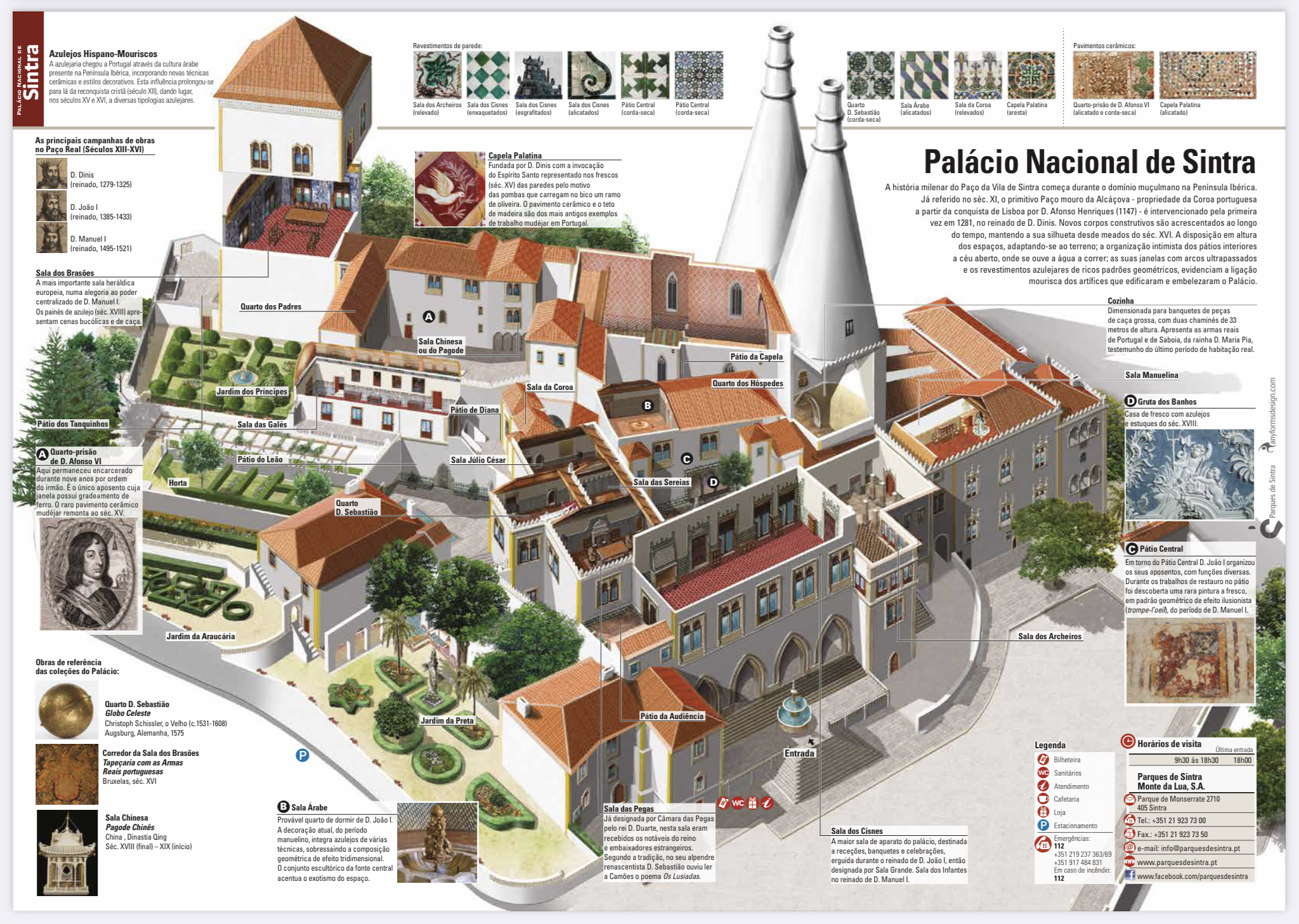
1. TERREIRO DO PALÁCIO
The Sintra National Palace is located in Largo Rainha Dona Amélia (in honor of the last queen-consort of Portugal, wife of King Manuel II). In front of the palace is a large area known as Terreiro do Palácio. Between the 15th and 20th centuries, this space functioned as a distribution area and was surrounded by several buildings in which various services operated. After the establishment of the Republic in 1910, these buildings were demolished and a large space was opened to become the main square of Sintra. There is also a fountain from the 16th century with a tower on top, a possible reference to the village of Sintra.

In the direction of the fountain, on the upper floor, are the “Joaninas Windows”, a set of five windows from the time of works carried out in the reign of King João I (1385-1433) and correspond to the first and largest room in the Palace built during this period. Small fleurs-de-lis were carved on the arches, a symbol used by D. João I for having been Master of the Order of Avis, whose insignia was formed by those flowers.
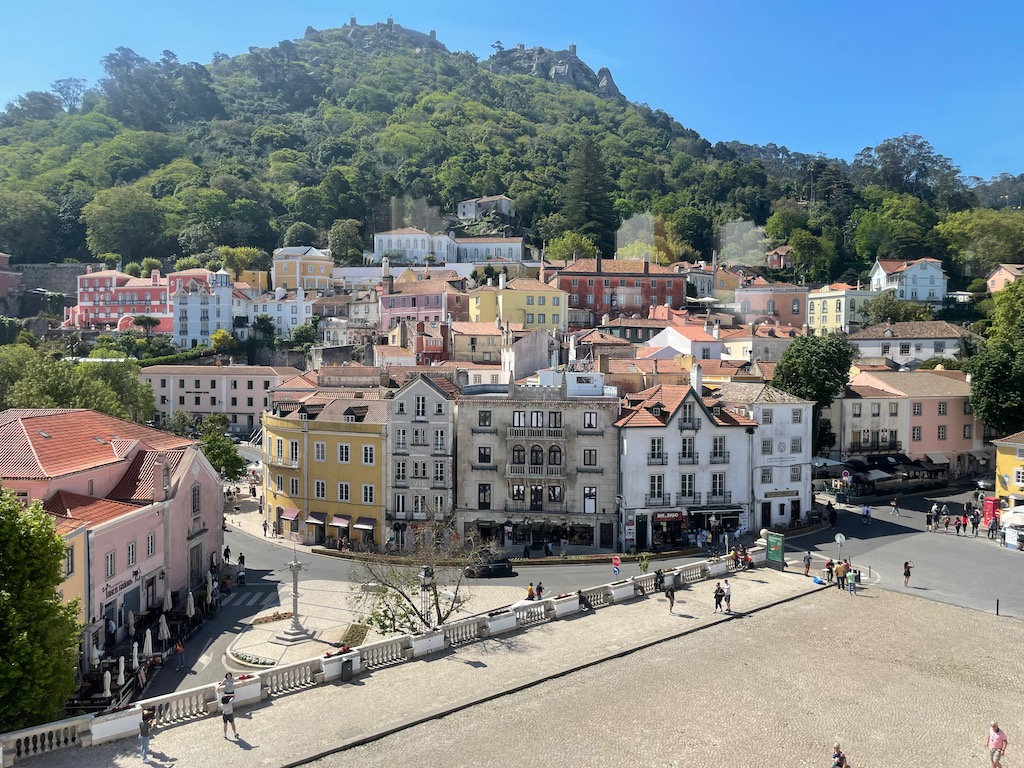
2. ARCHES
Leaving Terreiro do Palácio, go up some steps. There is a portico at the entrance with four Gothic arches, the arcades of the palace. This is an area that represents manorial power, since contracts, wills and deals involving documents were closed here. These activities were validated by notaries, bureaucrats and judges who were at the service of the Queen, who held power over the territory of Sintra.



3. ENTRANCE ROOM & ARCHERS' ROOM
Go up the stairs on the right to reach the Entrance Room where is one source, on the right, and a model of the National Palace of Sintra, on the left. This room connects two Royal Palaces. On the left, the Palace built in the reign of King João I (beginning of the 15th century). On the right, the Palace of the reign of D. Manuel I (beginning of the 16th century).

Moving forward, you arrive at Archers Room, connected to the Entrance Room. The room consists of a covered veranda with a floor of three different colors and several wooden and glass doors that open. This room is so named because, in the past, here were the ceremonial guards, known as “archers”, who carried a type of ancient weapon called halberds or archas.

4. SWANS ROOM (BIG ROOM) & YARDS
THE Swan Room it is the first room in the Palace of D. João I and D. Filipa de Lencastre and one of the main rooms in the palace, also known as the Great Room of the Palace of D. João I and D. Filipa de Lencastre. Until the 19th century, it was in this room that banquets, musical events, public receptions, religious celebrations, and even funeral ceremonies were held. However, the very strong earthquake of 1755 destroyed part of the walls and ceiling of the room, which were later rebuilt. Its ceiling is all painted and decorated with images of swans in various positions.


- AUDIENCE PATIO: Continuing through the Sala dos Cisnes to the other end, you reach the Pátio da Audiencia, a space formed by Renaissance columns from the 15th century, decorated with Moorish tiles with a bench and a throne. It was probably used for meetings or audiences until the 16th century. Initially fully open, it was later covered.

- VIEW FROM THE CENTRAL PATIO: To reach the next room, there is a view of a central courtyard (which will be visited later). From there you can see a type of rectangular tank that has been around since the 16th century. Go through the door on the left to reach the Sala das Pegas.
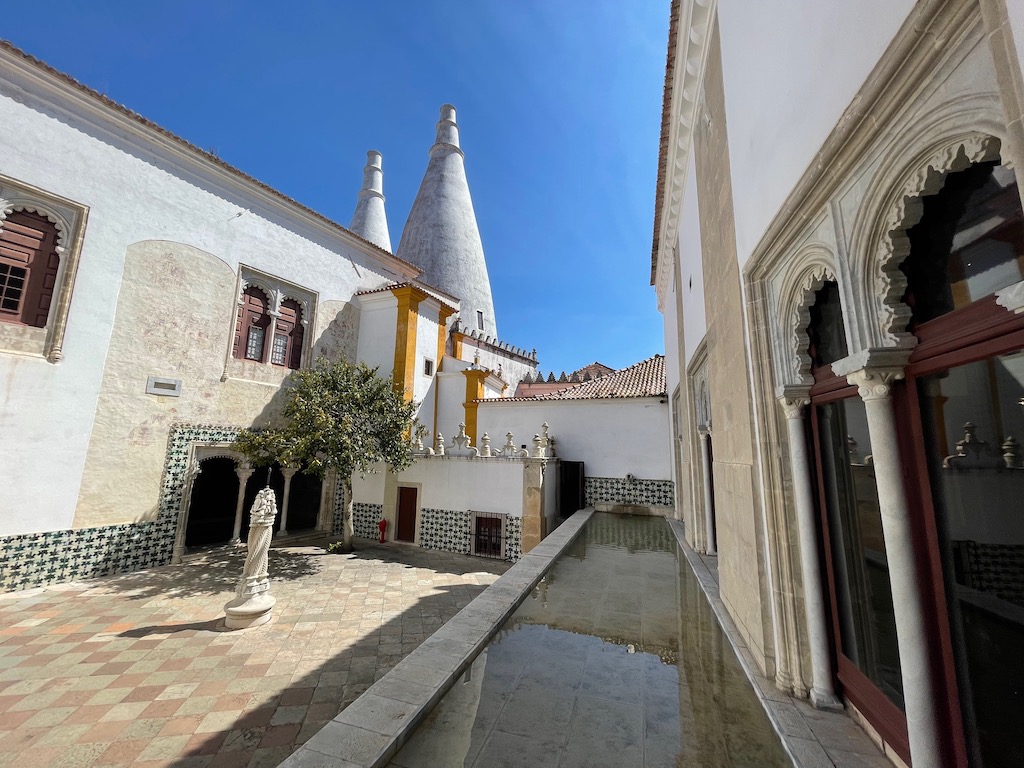
5. HANDLE ROOM
THE Room of the Handles it is the second room in the Palace of D. João I and D. Filipa de Lencastre. It was used for audiences with the king. With the walls decorated with tiles from the 16th century made in Seville, the ceiling painting of this room is considered the oldest in the palace, where 136 magpies (birds of the crow family, considered one of the most intelligent species in the world, known as “magpie” in English), the motto of D. João I (1385-1433) and a rose, in a possible allusion to the English House of Lancaster, to which Queen Filipa de Lancaster (1360-1415) belonged.

Common mat, a chair and a canopy, the room is believed to have been used for audiences with the king. In the 19th century, royal audiences lost importance and this room was used for banquets. In the room is also a marble fireplace which was given as a gift to King Manuel I by Pope Leo X, in 1515, and was installed in this room in 1898. There is also a luxurious 17th century desk where important objects and documents were kept.
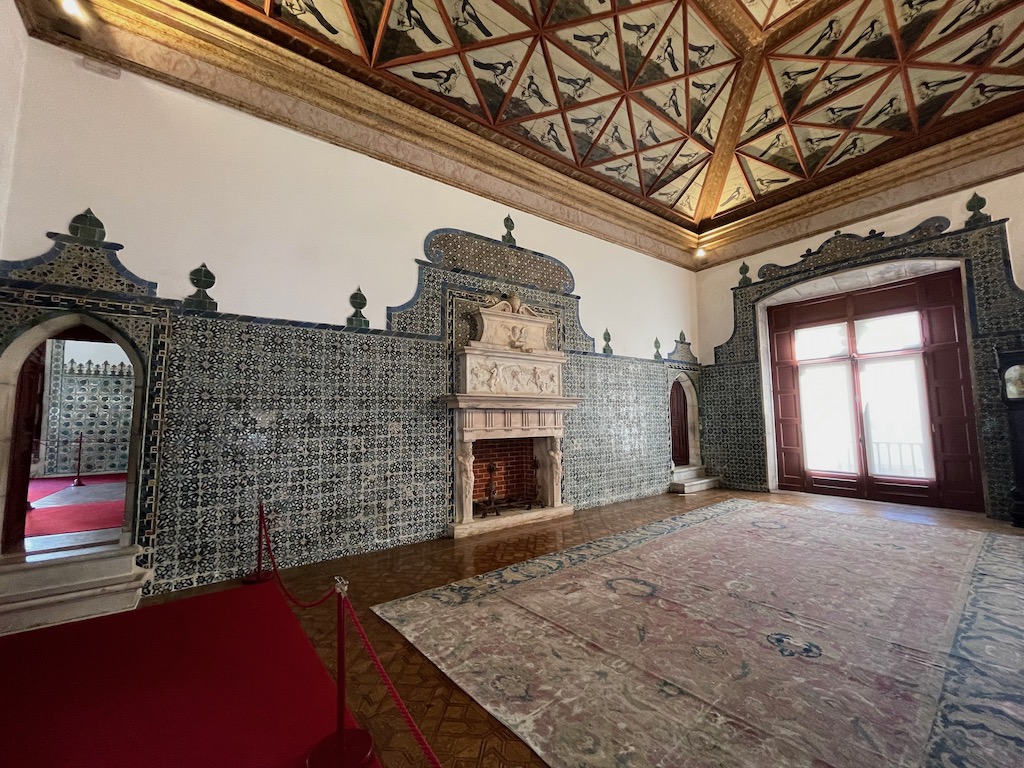
6. CHAMBER OF GOLD
THE Chamber of Gold it is the third room in the Palace of D. João I and D. Filipa de Lencastre and one of the places where the king received his most important personnel, as was the case with Queen Catherine of Austria (1507-1578). The place was also used as the king's dormitory and is also known as the D. Sebastião Room. Its name is due to the fact that, during the 15th and 16th centuries, the room was covered in gold. In the 19th century, the space was used as a dining room.

Currently, there is a beautiful bed of Italian influence, produced between the 17th and early 18th centuries, with medallions painted with mythological scenes with a red canopy. In silver brass, there is a coat of arms of the Counts of Sabugal, former owners of this bed that was taken to this place in the 20th century.

7. MERMAID ROOM (WARDROBE)
The fourth room of the Palace of D. João I and D. Filipa de Lencastre, known as Closet or Room of the Mermaids, it served to store in chests important goods for the king and queen, such as clothes, jewelry, silverware and other items. The room has relief tiles and decorated in blue and green colors dating from the 16th century. They were probably installed in the 18th century. The ceiling is decorated with mermaid designs.


8. DRESSING ROOM
Known as dressing room, this space was divided into three small compartments for greater privacy that could serve as support for the Wardrobe. The partitions were probably demolished in the 18th century, when it started to function as a place for preparing meals.

Among the highlights of this room are:
- Julius Caesar's Tapestry: a big tapestry 16th-century Flemish painting showing the episode in which the Roman Emperor meets the seer Spurina and was taken to the palace in 1939

- Celestial Globe: a golden globe, produced in 1575, representing the celestial sphere, with constellations and zodiac signs

- Picture of Saint John the Baptist: an early 16th-century painting depicting Saint John the Baptist with a lamb by his side, referring to the passage in which he baptized and recognized Jesus as the son of God
9. CROWN ROOM
This small one, decorated with tiles in blue tones and green and yellow details, takes its name from its wooden ceiling painted with a central coat of arms from the end of the 18th century.


When leaving the room, on the left, you reach the Diana's Courtyard, a small open-air space, decorated with tiles on the side walls and which has a water fountain and two side stairs that lead to the Sala das Galés.


10. WELSH ROOM
Welsh Room, also called Sala Grande, is the first room in a Palace built in the 16th century by King João III (1502-1557) with the function of connecting the main rooms in the south with the northwest wing of the palace. Its name owes its name to its vaulted ceiling with paintings of galleys (long, uncovered warships) from the 19th century. This large room was divided into smaller spaces, housing the Infante D. Afonso, returning to a unique space in the 20th century.

Among the highlights are pieces of Moorish ceramics produced in the Valencia region between the 15th and 18th centuries.

10. PASSAGE TO THE PRINCE'S GARDEN
A door gives access to the Prince's Garden, a geometric garden built in the 19th century to connect with the rooms of Príncipe Real, the future D. Pedro V; it's the Patio dos Tanquinhos, built in the reign of King Manuel I as a continuous space in the garden.

11. CHAMBERS OF D. JOÃO III & CORRIDOR
Chambers of D. João III They are made up of 7 rooms spread over two floors connected by a spiral staircase built in the 18th century. It is not known for what purposes they were used. In previous centuries, you went up to this upper floor through the Coat of Arms, further on in the visit. However, the upper floor is not included in the visit and consisted of a large room and two chambers, currently empty. In the past, they would have been the quarters of queens, including Queen D. Isabel de Aragon, the Holy Queen (1271-1336) and D. Leonor de Aragão (1402-1445).

One Hall it connects the Palaces of D. João I and D. Filipa (15th century) and of D. João III (16th century). On the left, there is the Sala dos Cobrasões and on the right, there is access to the former Palace of D. Dinis and D. Isabel de Aragão (13th century), the oldest part of the palace.

12. ROOM OF COAT OF ARMS
To access the Sala dos Brasões, one must go through a Manueline Portal in the Corredor dos Brasões, which also contains a 15th-century Flemish tapestry with Portuguese Royal Arms. THE Coat of Arms Room it is the most impressive room in the palace, the one that draws sighs because of its beautiful decoration. It is a square room measuring 12 meters on a side that occupies the entire noble floor of the tower built by King Manuel I (1469-1521) in the 16th century.
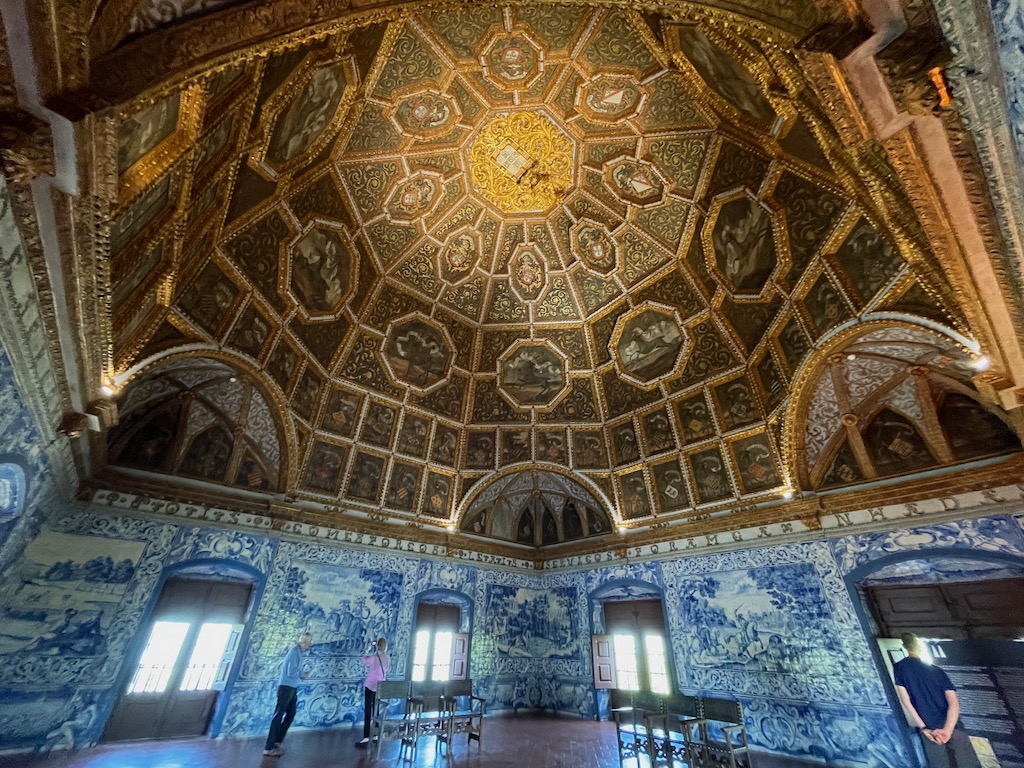
Some of the highlights are:
- TILES: The walls of the room are covered in blue and white tiles from the 18th century, painted between 1710 and 1715, with images of deer and bear hunting, as well as nobles in leisure time and enjoying the outdoors.

- DOME: The room has a dome, built between 1517 and 1518, with an octagonal base with the coats of arms of 72 Portuguese nobility families, with the coat of arms of King Manuel I on top, in addition to the coat of arms of his eight children with Queen D. Mary of Aragon.

13. D. AFONSO VI CHAMBER
At Chambers of D. Afonso VI consist of the oldest core of the palace (circa 1430-1440). It is a fortified structure built for defense purposes. Later, the Palace was renovated in the 13th century, by D. Dinis and D. Isabel de Aragão. The king handed over the lands of Sintra to the authority of the queen, and she was responsible for managing the village. The queens' quarters were in this area of the Palace, which was the most inaccessible of all.

The room, open to visitors, has a ceramic floor that dates back to the 15th century (around 1430 or 1440), one of the oldest in the palace. It is believed that it was in this room that King Afonso VI, who was removed by his brother, was imprisoned for the last 9 years of his life, being guarded by 300 soldiers. O bed exposed in this room is from the 17th century and made of wood and gilded metal. It was transferred to the Sintra National Palace in 1939 from the Ajuda National Palace in Lisbon. Next to it is a space believed to be the Great Room of the Palace of D. Dinis.

14. CHAPEL
The original construction of Chapel it took place in the 13th century during the reign of D. Dinis and D. Isabel de Aragão. It was expanded during the reign of D. Afonso V, in the 15th century, when the king reinforced the importance of the monarch in the Chapel, establishing norms for the liturgical service. The chapel ceiling has a Mudejar architectural style, incorporating Ibero-Muslim style elements with complex geometric patterns, it is one of the best preserved examples of the type in Portugal, contributing to the the palace has the largest set of Mudejar tiles in the country.

The ceramic floor was made using plied techniques (polygonal mosaic) and features geometric designs in various colors. In the 18th and 19th centuries, the chapel was profoundly altered. It was only in the 20th century that the decoration of the walls was recovered. Visitors can visit the chapel from the Tribuna da Capela, an elevated space opposite the altar.
15. ARAB ROOM
THE Arab room it is a square room that communicates directly with the Central Courtyard through a spiral staircase, leaving both this room and the Room of the State Bed (next room) separate from the rest of the palace. During the reign of D. Manuel I (1495-1521) geometric tiles were placed on the walls and, in the center, a source with marine mythological figures formed by a white marble basin and surrounded by ceramic pieces of various colors.

16. APPARATUS BED ROOM
Partially destroyed due to the terrible earthquake of 1755, the Apparatus Bed Room it was covered by a terrace that communicated with the Patio da Capela, which is next door. Initially, there was a tower here whose upper floor, above this room, collapsed. However, at the beginning of the 20th century, it was used as a dining room for the staff who were at the service of Queen Maria Pia. Currently, the space is used to display a beautiful bed 17th century made with ebony, silver and copper, richly decorated, which belonged to the Dukes of Cadaval. In the room there is also a portrait, from the end of the 17th century, of D. Pedro II, brother of King D. Afonso VI, and responsible for his imprisonment in the palace.

17. KITCHEN
After visiting this room, some stairs lead up to the large Kitchen, which is on the lower floor. It was built by D. João I with the aim of serving the entire palace, that is, it was in constant movement to serve the hundreds of people who made up the court and participated in banquets. Queen Catherine of Austria had more than 29 cooks, in addition to all auxiliary staff, pastry chefs, bakers and cheesemakers.

The kitchen was constantly supplied with water, firewood and food. Since the beginning of the 15th century, it has had piped water. Above the kitchen are two white chimneys 33 meters long, built in the reign of D. João I (1385-1433) and D. Filipa de Lencastre (1360-1415), which are one of the most striking features of the palace's architecture.

Another highlight of the little thing is a wall where there is a large iron stove, used to keep the food warm after it was prepared until the moment it was brought to the table to be served. Huge copper pots and large wooden furniture complete the decor of the space.

18. HANDBOOK ROOM
Returning to the Entrance Room, at the beginning of the tour, go on the opposite side, passing through the beautiful Manueline Portal to access the Manueline Room. This room was the Sala Grande during the period of D. Manuel I (1469-1521) and was later divided to accommodate the apartments of King D. Luís (1838-1889). In the 1930s, during the Estado Novo dictatorship, it returned to its original form. Some of the highlights are:
- CHANDELIER: The room with a beautiful chandelier glass center with 97 light points. It was acquired in Murano, in Venice, at Italy at the end of the 19th century and placed in the Sala das Pegas, which served as a banqueting room.
- TILES: The beautiful tiles with the personal emblem of King Manuel I (1469-1521) that decorate the half-height walls of the room were produced in 1931 from examples from the 16th century. The idea was to recall the importance of the role of the king during Portuguese overseas expansion and the glorious role of Portugal in this context.


19. ROOMS OF THE QUEEN D. MARIA PIA
Queen Maria Pia of Saboia (1847-1911) was the wife of King Carlos I and mother of the last king of Portugal, D. Manuel II. The eight rooms that made up the ancient Queen Maria Pia's quarters are located on the upper floor on the east side of the Palace of D. Manuel I. The Color Gallery, the Bedroom, the Toilet Room and the Queen's Apartment Room correspond to the balcony and the three chambers next to the Great Room of the Palace Manueline.
- COLOR GALLERY: It is a balcony of the Palace of D. Manuel I that served as a place of recreation. During the 19th century, it was closed with colored glass windows, receiving the name “color gallery”. It was used by Queen Maria Pia as a space for work and leisure. Currently, without the windows, it offers beautiful views of the village of Sintra and the Castelo dos Mouros, above the hill.


- BED ROOM: Between 1858 and 1858, during the reign of D. Pedro V, this room was adapted to receive the king and queen D. Estefânia. Look up to the ceiling to see the royal crown and “PS” (Peter & Stephanie) monogram. Currently, this room houses the bed where Queen Maria Pia (1847-1911) spent her last night in Portugal, on the eve of the establishment of the Republic, on October 5, 1910. A few hours later she left for exile.

- TOILETTE ROOM & TOILET ROOM: This room was dedicated to Dona Maria Pia's toilet, as the ritual of dressing, makeup and perfume was called. The washbasin, table and mirror have rococo details. On one of the walls is a portrait of the queen, painted in 1876. There is a door leading into the Toilet Room is a way of referring to the bathroom. There is a wooden toilet and a ceramic bidet.

- LIVING ROOM: This beautiful private living room was used by D. Maria Pia for work, rest or recreation. Tastefully decorated with dark wood furniture, paintings, textiles and pale walls with gold accents. The neo-Manueline fireplace displays the arms of the alliance between Portugal and Savoy.

- BATHROOM: This space was used for the queen's daily hygiene and had a washbasin and bathtub with hot and cold water taps. The door with colored windows was installed during the works carried out between 1857 and 1858, during the reign of D. Pedro V.

- CLOSET: It was in this room, which still retains the original cabinets built into the walls, that D. Maria Pia's white clothes and garments were kept.

20. CENTRAL PATIO & BATHS CAVE
Leaving the Queen D. Maria Pia Apartments, follow the Central Courtyard, an area that connects the Palace of D. João and D. Filipa, and has a twisted column in the center built in the 16th century. Take time to admire the blue and white tile decoration of the Gruta dos Banhos. This is a space protected from the sun in which jets of water that spurt from the tiny holes in the walls give it a playful dimension.

The grotto was built in the late 15th or early 16th century and redecorated in the 18th century. The ceiling has stuccoes depicting the Creation of the World (central composition), the Four Seasons (corners) and mythological themes.
OTHER AREAS: STORE, CAFETERIA AND GARDENS
Renovated in 2018, the Store do Palácio has many gift items, books, decorative items, porcelain inspired by those used by Queen Maria Pia, Hispano-Moorish tiles from the 16th century, among others.

When you leave the store, you are in Lion's Courtyard, decorated by a fountain, green tiles and a reflecting pool. The patio gives access to the entrance to the Patio do Leão Cafeteria, which is temporarily closed.

Go right to the area of gardens, where you will find a small vegetable garden with aromatic herbs, the Araucaria Garden it's the Black's Garden. This latter garden is so named because there is an 18th century painting of a woman of African descent who is doing laundry. The exit is made through a side door that gives access to the Palace Terreiro.


The visit to the gardens can be done free of charge, it is necessary to enter through a door to the left of the main staircase. The gardens are organized in ascending levels, which follow the unevenness of the land around the palace.
HOW TO GET TO THE NATIONAL PALACE OF SINTRA
The Sintra National Palace is located right in the historic center of Sintra. The building's two large white chimneys, built in the reign of King João I, make no mistake about where the palace is. Below, check out the main ways to get to the Palace.
- WALKING: The Sintra National Palace is just a 10-minute walk from the Sintra train (“train” in Portugal) station. The walk is relatively quiet and pleasant.

- BUS: Once in Sintra, take the bus (“bus” in Portugal) from Route 434, Circuito da Pena, from Scotturb. A one-way ticket for this route costs €3.90 and the hop on hop off option costs €6.90. The first bus leaves at 9:30 am and you can check timetables and stopping points here and buy tickets in this link.
- TUK TUK: It is a cheaper alternative to Uber, although without the same comfort. Just like the tuk tuk in Asia, you must negotiate the price before entering. We used the tuk tuk on two occasions and it was a good way to get around the traffic.
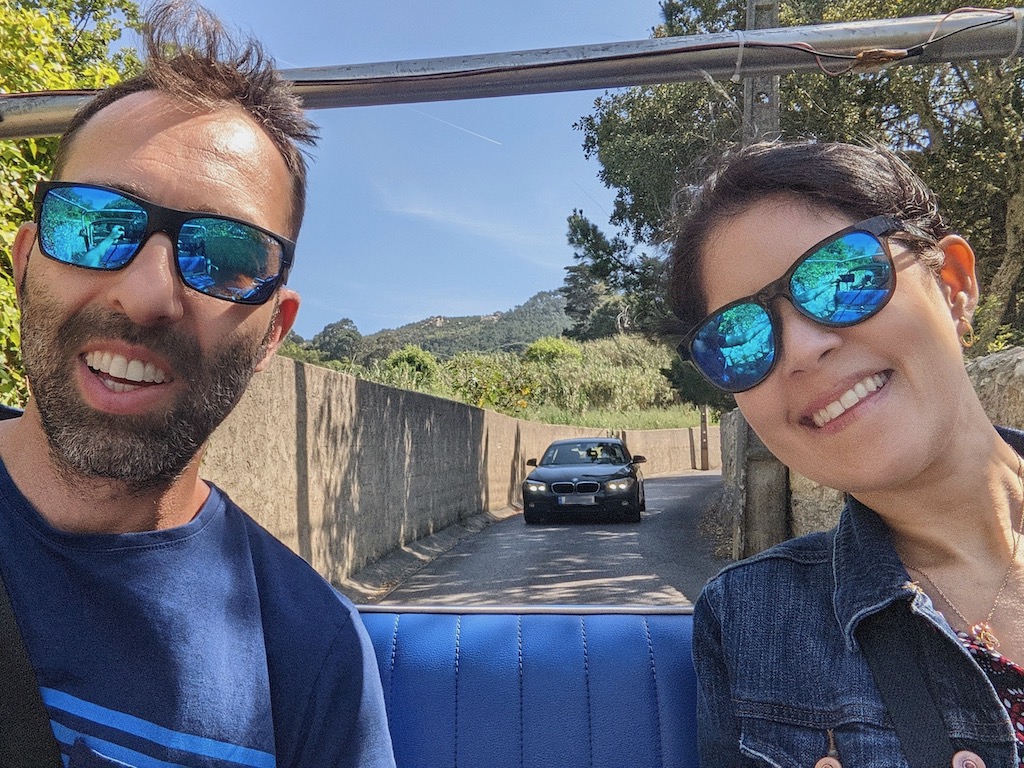
- UBER: Uber works very well in Sintra and is an interesting option at fair prices. It's a good one for those who want comfort, air conditioning, but it can be hampered by the rather annoying traffic on weekends and summer.
- EXCURSIONS: For those who are in Lisbon, a good option is to participate in a guided tour that includes visiting other places, optimizing your time. Check out some of the options below.
IMPORTANT INFORMATION
Sintra National Palace
- Address: Largo Rainha Dona Amélia, 2710-616 Sintra, Portugal
- Schedules: daily from 9:30am to 6:30pm (the ticket office closes between 12pm and 1pm, but there is a ticket vending point available)
- Entrance: €10 (from 18 to 64 years old) | €8.50 (from 6 to 17 years old and over 65 years old) | free for the gardens
Save these tips to Pinterest!

Read more about Portugal:
HARBOR
- Portugal: What to do in Porto – 2 or 3 days itinerary
- Portugal: How to get from Porto Airport to the center
- Port: Hotel One Shot Aliados Goldsmith 12
- Portugal: Guided Tour of the beautiful Palácio da Bolsa in Porto
- Restaurante Onze: Haute cuisine in Porto
- Porto: Restaurant Francesinhas Al Forno da Baixa
- Cálem: Tour in the most visited cellar in Port Wine
- Vices at the Table – Bad Habits: Pizza and culture in Porto
- Porto.CARD: Savings tip in the city of Porto
- Porto: Lello Bookstore, the most beautiful bookstore in the world
- Portugal: Ribeira Square Restaurant in Porto
- Kind Kitchen: Casual Vegan Food in Porto
- Portugal: Curiosities and Tours on the 6 Bridges of Porto
LISBON
- Portugal: How to get from Porto Airport to the center
- Lisbon accommodation tip: Brown's Downtown Hotel
- Portugal: What to do in Lisbon – 3 days itinerary
- Portugal: Guide to where to eat in Lisbon (with map!)
- Lisbon: Dinner with Fado performances at Adega Machado
- Lisbon Card: Savings tip in the Portuguese capital
- Portugal: The historic Jerónimos Monastery in Lisbon
- Portugal: How to visit São Jorge Castle in Lisbon
- Portugal: Visiting the Belém Tower in Lisbon
- Portugal: How to get from Lisbon Airport to the center
- Portugal: Discover the National Pantheon in Lisbon



